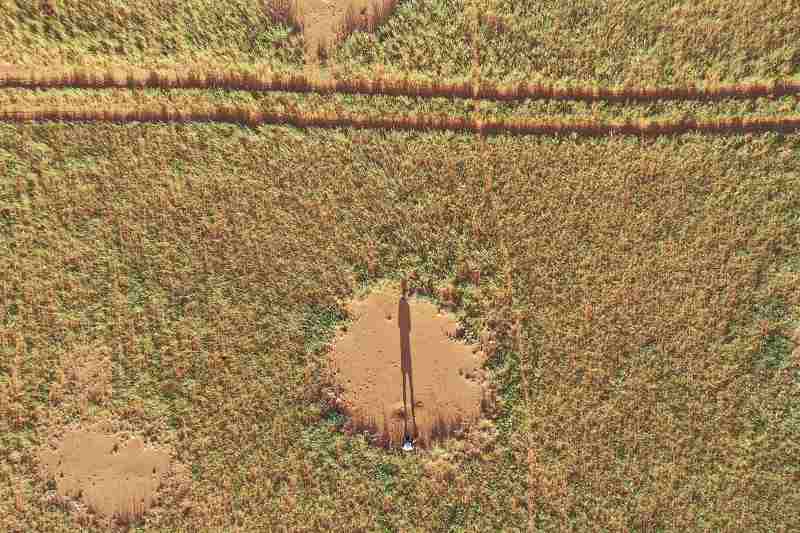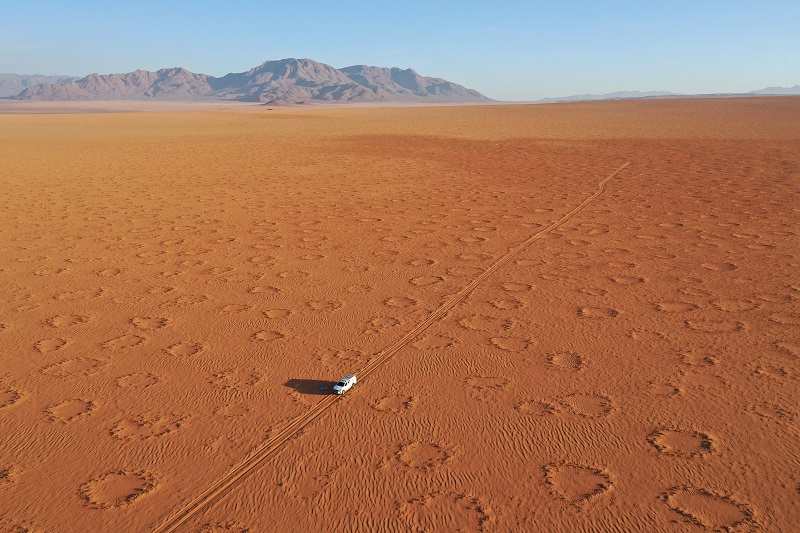
Mysterious “fairy circles,” or patches of bare soil on arid grassland, have puzzled scientists for decades.
17:28 JST, January 14, 2023
The origins of eerily perfect circles in the eastern Namib desert have puzzled scientists for decades. The circles, seen as patches of bare soil on otherwise arid and grassy terrain, appear equidistant to one another, as if someone methodically took a cookie cutter to the ground.
Satellite imagery shows there could be millions of these “fairy circles” in the area, but scientists have debated what could explain the existence of even one, which can span up to 20 meters in diameter. Perhaps termites are chomping at the plant roots? Maybe the grasses are somehow creating the patterns? Or a toxin has decimated the soil? Or maybe aliens are sizing up the desert as a potential landing spot? (Spoiler: It’s never aliens.)
“There must be very strongly ordering forces behind the creation of these pattern because otherwise it would be much more noisy, much less order,” said Stephan Getzin, who is a desert ecologist at the University of Göttingen and has published numerous papers on these circles. “That’s the fascination about the fairy circles.”
Now, Getzin and his colleagues have acquired new compelling evidence to explain the mysterious circles in the region. They point to a fierce competition among plants for water on the arid terrain. Researchers say periodic vegetation patterns like fairy circles could also increasingly pop up around the world under a warming climate. Simply put, plants may be battling one another to survive the dry conditions, stealing water away from their neighbors, which leaves a bare circle.
Getzin first saw these mystery circles in person when he was studying at the University of Namibia more than 20 years ago. He published his initial study on the topic in 2000, in which he named the phenomenon “fairy circles” because of its vague similarity of “fairy rings” of mushrooms often seen in forests. (The two are not related except in name, and neither were created by fairies.)
The Namibian fairy circles are unusual not only in their appearance, but also location. They manifest in one of the driest areas in world, occurring in a very narrow sliver that receives only 70 to 120 millimeters of annual rainfall. Move just 30 kilometers to the east where annual rainfall is around 150 millimeters: There, Getzin says, no fairy circles are in sight and grass coverage is continuous.
“This is a very strong indication that this is a water-driven or climatically-driven phenomenon,” Getzin said. “The fairy circles are basically an expression that there is not enough moisture to sustain continuous vegetation cover. The grasses organize themselves just to harvest that limited water in the most optimal way.”
Over the past three years, Getzin and his team gathered field data in Namibia to explore this hypothesis. The team installed sensors to measure water content in the soil and excavated grass. After a rain event, they found that grass grew inside and outside the fairy circle. Within a few weeks, however, the grass inside the circle died while the plants on the periphery persisted. They also found that the soil moisture in the top few inches inside the circle decreased despite the fact that there was no grass present.
Getzin explained that the plants on the circle’s periphery were outcompeting the grass inside the circle for water. The team even found that these periphery plants have longer roots, allowing them to laterally siphon water better. As a result, there’s not enough water left inside the circle for grass to grow.
But why are the plants arranged around a circle?
The shape of a circle allows individual grasses to maximize their water availability, Getzin said. A circle, which has a small circumference-to-area ratio, limits the number of surrounding plants and boosts the amount of water available to those plants. Whereas in a square, more plants would have to share the same amount of water.

Some researchers see these spatial patterns as a vegetative adaptation for coping with hotter, drier environments, which are ever increasing under climate change.
“From the competition point of view, this is the most logical structure to access these limited resources of water,” Getzin said.
Getzin acknowledges that plants don’t have brains, per se, but this is an intelligent mathematical pattern. Several of the circles are also evenly spaced from one another to create a uniformly repeated honeycomb pattern – part of its eerie appearance. Researchers call this uniform design a turing pattern, which was first explained by mathematician Alan Turing.
“It’s not only animals which act as ecosystem engineers. Plants are doing the same thing,” Getzin said. “There’s increasing awareness that plants may be more intelligent than we believe.”
Outside of Namibia, fairy circles have also been found in the Australian desert. Getzin and his team traveled to Australia and determined the circles were also formed through plant competition and self-organization.
Some researchers see these spatial patterns as a potential tool for coping with hotter, drier environments, which are ever increasing under climate change.
“People are talking about tipping points, approaching a point where a system collapses,” said Ehud Meron, a physicist at Ben-Gurion University of the Negev in Israel who has published papers with Getzin. “There are many alternative pathways of response. Some of them are resilient.”
Meron and his colleagues are studying how threatened ecosystems can survive through the formation of spatial patterns. His research shows that vegetation will rearrange and self-organize in response to how dry the environment is.
A well-hydrated environment may have uniform vegetation, but vegetation becomes patchier as precipitation decreases to maximize water availability for competitive plants. Uniform vegetation can transform into gap patterns (like the fairy circles). Gap patterns can morph into stripes of vegetation in even drier climates. When rainfall further decreases, stripes can form into spots.
Not everyone is onboard with Getzin’s explanation. Australian ecologist Fiona Walsh and her colleagues assert the fairy circles in Australia were created by termites. Yet Getzin said he did not find compelling termite evidence in his samples in either Australia or Namibia.
Marion Meyer, a fellow fairy circle researcher, does not believe termites or ants are the cause of the Namibian fairy circles but still finds Getzin’s explanation unconvincing. He proposes another theory: A toxic plant called euphorbia once grew where the fairy circles are now and killed beneficial microbes, which help grasses survive in the desert. He said the plant’s toxic latex also prevented the soil from absorbing the water, explaining the lack of water near the circle’s surface.
Getzin has also published literature countering Meyer’s microbe theory, but Meyer said that “in science, it’s good to disagree and wonder.”
“The fairy circles, it’s very difficult to prove conclusively,” said Meyer, a plant chemist at the University of Pretoria in South Africa. “I think many years later, a scientist will provide more evidence. Then eventually the correct theory will be accepted. But at the moment, it’s still open.”
"News Services" POPULAR ARTICLE
-

American Playwright Jeremy O. Harris Arrested in Japan on Alleged Drug Smuggling
-

Japan’s Nikkei Stock Average as JGB Yields, Yen Rise on Rate-Hike Bets
-

Japan’s Nikkei Stock Average Licks Wounds after Selloff Sparked by BOJ Hike Bets (UPDATE 1)
-

Japanese Bond Yields Zoom, Stocks Slide as Rate Hike Looms
-

Japan’s Nikkei Stock Average Buoyed by Stable Yen; SoftBank’s Slide Caps Gains (UPDATE 1)
JN ACCESS RANKING
-

Keidanren Chairman Yoshinobu Tsutsui Visits Kashiwazaki-Kariwa Nuclear Power Plant; Inspects New Emergency Safety System
-

Imports of Rare Earths from China Facing Delays, May Be Caused by Deterioration of Japan-China Relations
-

University of Tokyo Professor Discusses Japanese Economic Security in Interview Ahead of Forum
-

Japan Pulls out of Vietnam Nuclear Project, Complicating Hanoi’s Power Plans
-

Govt Aims to Expand NISA Program Lineup, Abolish Age Restriction

























